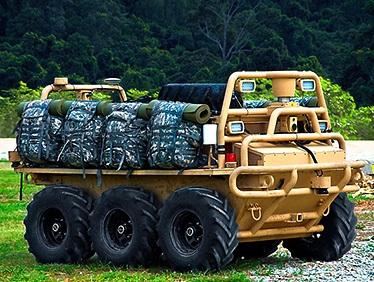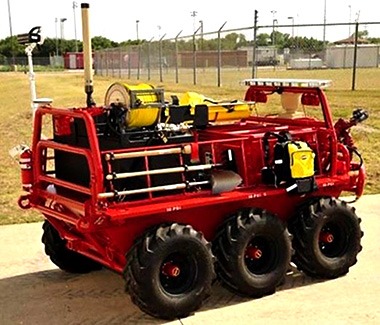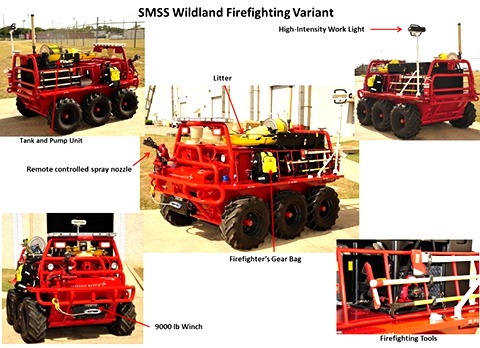by Mike Kennedy.png)
Editor’s Note: At the Ready Magazine does not endorse specific products, and this article should not be construed as an endorsement of the specific technology described within. This article simply describes the design features of the Ox UGV and explains how Lockheed Martin is adapting the vehicle to the first responder market.
At the Ready recently discussed the merits of the Ox, an autonomous unmanned ground vehicle developed by Lockheed Martin for military purposes, with Don Nimblett and Myron Mills from Lockheed Martin. They originally developed the system to meet the centuries-old problem called Soldier load. The Army wanted a system capable of carrying the weight of a full 9-man infantry squad that could fully support the squad during a mission. There were many other key performance parameters, key system attributes, and additional system attributes in the requirements document, but those are not important for the telling of this story. The bottom line was that it had to carry a squad’s load and support the squad during the mission.

Lockheed Martin has taken the Ox and adapted it for first responder use. This article focuses on how a technology developed for the DOD could apply to the First Responder market. Lockheed Martin cites several potential applications. “The Ox… can provide a very mobile platform for carrying significant amounts of supplies, gear, and equipment used by wildland firefighters; special tactics and weapons units of all law enforcement agencies; and rugged and remote terrain search and rescue teams, just to name a few,” said Nimblett. Mills pointed to “the autonomous navigation capabilities…First, autonomy reduces the workload on the operator; allowing him/her to focus more on their primary job, instead of babysitting a large robotic vehicle. Second, autonomy provides the capability of allowing the vehicle to seek passable routes, without the operator being with it, to get to the objective. Ox is a compact-car-sized vehicle and, as such, it cannot follow every path that a human can take, but it could be sent on an alternative pathway, allowing it to still provide the vital supplies and equipment at the objective.”
It is probably easy for any experienced firefighter, wildland or urban, to imagine cases where the size of the Ox would have precluded it from following them directly. The questions then could be, how would the Ox have chosen an alternate path, or could it have met the firefighter where needed? Mills’ response: “The autonomy used for Ox accommodates the input of geo-registered, digital maps, which allow for the Ox to operate on all road and trail networks, in both urban and rural settings. The autonomy permits the establishment of pre-designated paths that the vehicle could be commanded to follow, allowing it to shuttle back and forth between critical sites, or to return for supplies and make its way back to the fire fighters. This capability has application worldwide.”
Additional benefits from the Ox’s autonomous capability could reduce both the physical and cognitive burdens inherent in the First Responder mission. One of the more usable autonomy features of the system is the follower capability. Nimblett elaborated, “Using a laser radar system (eye-safe), the Ox is able to capture a 3D image of anyone standing in front of it, send that image to the navigation computers, and allow the computer-sensor coupling to lock onto the image of the person selected for leading the vehicle around. Once locked on, the vehicle will follow the person, turning as the person turns and stopping when the person stops. If the person needs to move at a jogging pace, the vehicle will pick up speed to stay with the person. If another person or object (large boulder, tree, another vehicle) comes between the Ox and the person it is following, the Ox will detect the object/person and either go around it to stay with the person being followed, or it will stop if there is no clear alternate path available.”
As was discovered in military experimentation, there are certain cases where autonomy is not the desired method of operation for the responder. In these cases, the responder can tele-operate the system, driving it by remote control from a standoff distance. Mills described it this way: “In situations where complex HAZMAT or potentially explosive situations must be tackled, this mode of operation can keep responders well back from the immediate danger zone. Equipment such as pumps and remote control monitors (water nozzles) can also be operated by tele-operation as the vehicle is maneuvered to lay down a water screen or cover an area fire. This type of system could possibly have been sent into the fertilizer plant at West, Texas, to do a preliminary reconnaissance and attack the fire, keeping the first responders well away from the hazardous site.”
Other recent tragedies, such as the devastating tornadoes in Moore, Oklahoma, provide possible use cases for this kind of vehicle. Like responders and emergency management professionals everywhere, Lockheed Martin studied the situation and learned a great deal from it. They believe that their system could have made a big difference in Moore. “We specifically thought about the First Responder effort in Moore. In that case, the vehicle could have been used to literally follow responders from location to location while they were moving on foot through the rubble,” said Nimblett. “By virtue of the vehicle’s modest size, high mobility, and large torque, the vehicle could have gotten over and through debris and rubble that kept fire trucks, MICUs, rescue trucks, and squad cars out. The vehicle could have carried all the tools (shovels, pry bars, chain saws, axes, hydraulic tools, trauma treatment supplies, litters, stokes baskets, etc.) needed to work through the rubble to free survivors, locate victims, and perform casualty evacuation. The vehicle’s winch could have been used to help clear rubble and debris, and the vehicle could have been a source of high intensity portable lighting as well as communications. Alternative payloads are only limited by the imagination and the available cargo-area space and weight limit of 1500 pounds.”
The Ox can follow the responder, but can it carry all the gear that might be required? Apparently so, as was evidenced by how soldiers used it during a recent deployment to Afghanistan. “The payload of the Ox is 1500 lbs., but in actual usage by U.S. military, in-theater, it carried considerably more (not recommended as standard practice). Mission equipment packages (MEP) that can be carried by Ox are only limited by the weight and cube of the Ox. Essentially, if it will fit and stay within the weight limits, Ox can carry it.” Other military uses of the vehicle discovered during the deployment could also be used by responders. “For power, Ox can generate up to 4 kW, and with a minor modification, can double the power available for off-board use,” Mills explained. “A hydraulically powered generator has been added that provides 6 kW of 120 VAC power. Additionally, the hydraulic system can be used to power tools such as Jaws of Life®. Extensive communications equipment can be carried, as was done by the U.S. military in-theater, which consisted of generators and banks of radios for use as mobile tactical operations centers. One unique configuration employed by one military unit was to use Ox as a mobile welding unit. The Ox was hitched to a trailered arc-welding unit, and the oxy-acetylene bottles and hoses were mounted on the cargo deck of the Ox. It worked quite well.”
Comms are a huge issue in times of disaster. Not only are lines down, poles destroyed, and towers crumbled, but also in the large-scale disasters, help will come through mutual aid agreements and other departments from all over the state and country, from all levels. Interoperability issues can severely hamper response in these situations. The communication equipment packages on the Ox can help overcome these issues. Mills explained, “There is no reason the Ox could not be used for SATCOM, mobile cell-towers and repeaters, to significantly extend the communications of units deployed to remote areas. In fact, we have controlled the Ox from 200 miles away, using SATCOM. We achieved that success in November of 2012. Lockheed Martin can also provide the Universal Communications Platform (UCP), which enables interoperable communications between radio assets of First Responders, Military, and Homeland Defense organizations. The UCP capability can be mounted on and powered by an Ox and used as a self-mobile incident command post communications system. The SATCOM system can also establish a mobile WiFi hot spot enabling First Responders working near the vehicle to reach the Internet for communications or data via their regular consumer wireless devices, even if no cellular coverage is available in the area.”

The Ox appears to be a very versatile platform as well. Lockheed Martin has developed different payload packages that lend themselves to differently configured vehicles for different missions. “Currently, we have Ox variants equipped to carry general cargo; to conduct reconnaissance, surveillance and target acquisition (RSTA); to conduct chemical, biological, radiological, nuclear and high-explosive sensing/detection; and to conduct counter-improvised explosive device (CIED) missions,” said Nimblett. “We have recently equipped one variant for the firefighting role (called Red Ox), with particular emphasis on wildland fire support. The vehicle has been painted fire engine red and has a remotely controlled spray nozzle mounted on the front, with skid mounted pump and hose system, with a litter kit for casualty evacuation mounted on the main cargo floor. Additionally, fire-fighting tools and gear are mounted on the side racks and it is equipped with a 9000-pound capable winch, which can be mounted front or rear on the vehicle. Because the vehicle applies tremendous torque and traction to the ground with its 6X6 drive, it can drag quite a length of hose a considerable distance over rough terrain. The vehicles we sent to Afghanistan were equipped with a Warrior Aid and Litter Kit (WALK) and two Skedco emergency rescue stretchers, each. A large amount of trauma treatment and first aid gear can be carried on the vehicle. Because of our ample supply of electrical power, a small refrigerator could be incorporated that could carry whole blood or plasma. We will unveil the vehicle at an upcoming firefighting-oriented show, very soon.”
The Ox is definitely an interesting platform, but it is important to understand the design philosophy behind it, as well. Mills says it is the “robotics triad. It consists of a mobile platform that is relevant to the tasks, roles and missions required to be effective; a lightweight, wearable operator control unit, or OCU, that is tuned to the vehicle and the mission equipment packages (MEP) it carries; and the autonomous navigation capability. The OCU must not only be capable of properly controlling the vehicle and MEP, but it must be designed to maximize all the capabilities of the vehicle platform and the MEP. Particularly important is ease of use. The controls and displays must be intuitive and easy to remember and employ. We believe autonomy is critical for a robotic system to be relevant on the battlefield, fire scene, HAZMAT situation, etc. Without autonomy, the operator is required to remote control the system, which significantly detracts from his participating in other tasks that are vital to an operation. In the military, operator distraction is unacceptable, as it takes a set of eyes from helping the unit survey the area, and a trigger-finger off a needed weapon.”

So, the last question then, what happens if we break it somehow? To answer, Nimblett explained that Lockheed Martin purposely built the vehicle to be maintenance friendly. “We have deliberately chosen to keep the vehicle as maintenance friendly as possible. The chassis and powertrain are off-the-shelf items. Any garage mechanic can maintain the primary mobility platform. Items that will require some special technical skills include the main computer system, the sensors, and any mission equipment packages installed by the customer. However, the sensors and computers could simply be replaced with new ones or ones that have been repaired by a higher-level maintenance echelon, or the manufacturer. Even the sensors are largely off-the-shelf items and in many cases can be readily replaced by service personnel with only minimal training.”
Author’s Note: The author conducted extensive experimentation with the military version of the Ox in 2008 as an experimentation manager at the U.S. Army Maneuver Battle Lab at Fort Benning, Georgia.








